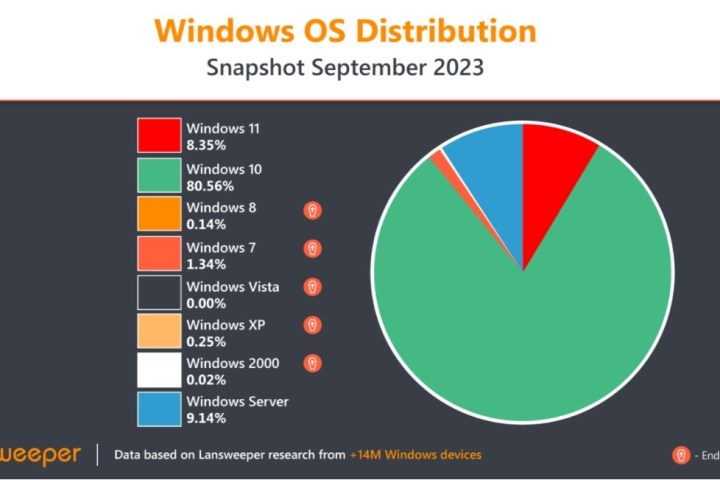In the consumer space, Windows 11 adoption has been ticking along at a reasonable pace. For businesses, however, the OS may have reached its limit, as businesses struggle to upgrade machines to meet the minimum requirements.
IT asset management group Lansweeper has observed that the adoption of Windows 11 now stands at 8.35% as of October 2023, a slight jump from the 5.74% seen in September 2022. However, having conducted research on approximately 33 million Windows devices in the enterprise sector, Lansweeper has concluded that it is largely device incompatibility that is stalling Windows 11 updates on a grand scale.

One of the group’s primary findings revealed that approximately 67.5% of workstations are eligible to automatically update to Windows 11, as they have the necessary components required for the rollout: the CPU, the RAM, and the trusted platform module (TPM). In particular, 67.5% of CPUs, 93.8% of RAM, and 74.8% of TPMs met the requirements. However, this still leaves 32% of devices that are not compatible with the
IT staff also has the option of updating devices manually. But therein lies another problem, not only in the time-consuming task but also in continuing upkeep, especially if devices do not remain compatible. Windows 11 features basic spec requirements for installation, which include a 1 GHz processor (or faster) with two or more cores on a 64-bit processor or SoC, 4GB of RAM, and at least 64GB of storage. Critically, it requires the use of a TPM, which is only supported on newer Intel and AMD processors.
Lansweeper noted that the uptick in Windows 11 upgrades has been accounted for by businesses replacing old devices with new workstations featuring more powerful specifications, in addition to the latest software. With this method, the transition to
“This report serves as a call to action for businesses and IT professionals. It underscores the urgent need for organizations to reassess their strategies for Windows 11 adoption,” Esben Dochy, Lansweeper senior technical product evangelist, said in a research report.
“Having a well-thought-out migration and upgrade plan, backed by accurate IT asset data, is crucial for a successful long-term IT strategy,” he added.
Legacy systems including Windows 7, 8, and XP have finally been retired for good and are among those being replaced with Windows 11. Since these systems no longer receive updates, in particular, security updates from Microsoft, they are the most susceptible to cyberattacks. Windows 10 currently is the most popular of all the Microsoft systems with an 80.5% adoption rate. However, the brand is also winding down support for this version, which will enter its end-of-life phase on October 14, 2025.
For consumers, Windows 11 adoption has been solid since its release. However, Windows 10 still overwhelmingly retains the top spot for the overall share of PCs, according to Tom’s Hardware.
Editors' Recommendations
- Windows 11 might nag you about AI requirements soon
- You’re going to hate the latest change to Windows 11
- Windows 11 tips and tricks: 8 hidden settings you need to try
- Microsoft announces a new threat to push people to Windows 11
- How to adjust screen resolution in Windows 11 and older




